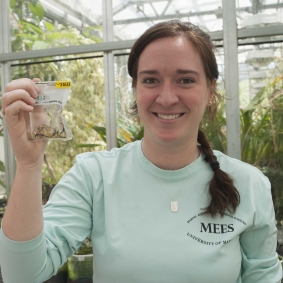Knauss legislative fellowships in Congress help build careers — and they're fun and educational. See our video and fact sheet for details.
Brittany Marsden

Fellowship Institution:
NOAA Formulation and Congressional Analysis DivisionStart Year:
2015Brittany Marsden served as the inaugural Knauss Fellow in the Formulation and Congressional Analysis Division at the National Oceanic and Atmospheric Administration (NOAA). As a program analyst in budget formulation, she helped the administration to develop its research priorities, communicate the significance of NOAA research to Congress, and help scientists get the funding they need to carry out their work.
Marsden was a doctoral student in the Marine Estuarine Environmental Sciences Graduate Program at the University of Maryland. Her research addressed the genetic diversity and growth patterns of submersed aquatic vegetation (SAV). By better understanding these patterns, she has been able to draw conclusions about the capacity of regional SAV populations to acclimate or adapt to dramatic environmental changes. Those results could help scientists to grasp how climate change might affect the Bay's ecologically important SAV communities.
Some of Marsden's first exposure to marine ecology came from studying sponges as an undergraduate student at the University of Richmond. Before beginning graduate school, she spent a year in Maryland working in environmental education. During that time she became intimately acquainted with the Chesapeake Bay and the environmental, ecological, and economic issues facing the region. Those experiences sparked her desire to pursue an interdisciplinary career in marine conservation.
Following her fellowship, Marsden accepted a position as an analyst in NOAA OAR's Formulation and Congressional Analysis Division.
Fellowship Experiences Blog Posts
See Brittany's posts to Fellowship Experiences, Maryland Sea Grant's blog written by and about graduate fellows and their research.
Call for Symposium Presenters and Authors
The Chesapeake Rising: Innovative Law and Policy Solutions for Climate Adaptation in Coastal Communities symposium will explore key legal and policy considerations that affect climate adaptation strategies. It provides a unique opportunity for upper-level law students and early-career lawyers to present and publish their legal scholarship.
Program Announcements
-
-
Maryland Sea Grant has program development funds for start-up efforts, graduate student research, or strategic support for emerging areas of research. Apply here.
News and Blogs
Video Gallery
Sea Grant Film Explores a Diminishing Smithville
Smithville is a community on Maryland’s Eastern Shore, on the edge of the Blackwater National Wildlife Refuge. A century ago, Smithville had more than 100 residents. Today, it has four, in two homes: an elderly couple, and one elderly woman and her son, who cares for her.
Featured Fellow
Featured Research Project
Developing a habitat model for mysids, an important link in Chesapeake Bay food webs
Mysids are important mesozooplankton prey for many species of fish in Chesapeake Bay and are an important link in transferring energy from lower to upper trophic levels. Mysids also serve as biological vectors for benthic-pelagic coupling due to their diel vertical migration and omnivorous prey-switching behavior, which makes mysids important regulators of food web architecture. Despite their central role in coastal food webs, surprisingly little is known about mysid ecology and dynamics in Chesapeake Bay.
The Blue Crab: Callinectes Sapidus
An essential resource for researchers, students, and managers. Get your copy today!


©2025 Maryland Sea Grant. All rights reserved.
5825 University Research Court, Suite 1350 | College Park, MD 20740
Phone: (301) 405-7500 | Fax: (301) 314-5780 | Contact Us



